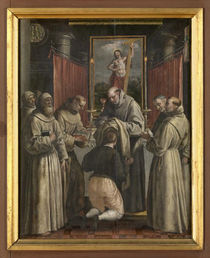The Catholic Defender: Saint Louis of France
- Donald Hartley

- Aug 24
- 3 min read
Updated: Aug 25
Deepertruth with special permission and aid with Franiciscan Media, a great team for the Lord
https://deepertruthdon.podbean.com/e/deepertruth-stand-in-the-gap-with-us-and-saint-louis-of-france/

(Lous IX of France)
Crusading king. Canonized as a saint for his concern and compassion for the poor.
King Louis IX of France led a Crusade in the mid-1200s. He died during another Crusade in 1270. In 1297, to honor the king's efforts as a Crusader, the Roman Catholic Church made Louis IX a saint.
At his coronation, St. Louis bound himself by oath to act as God's anointed king. St. Louis is known for interpreting his kingly duties in the light of faith.
Louis IX, also called Saint Louis, (born April 25, 1214, Poissy, France—died August 25, 1270, near Tunis [now in Tunisia]; canonized August 11, 1297, feast day August 25), king of France from 1226 to 1270, the most popular of the Capetian monarchs.
St. Louis is known for the Gateway Arch, the tallest monument constructed in the United States at 630 feet (190 m). The Arch pays homage to Thomas Jefferson and St. Louis's position as the gateway to the West.
King Louis IX was the only French king to become a saint, but not the only French royal. In fact, his younger sister, Isabelle, is also recognized as a saint by the Franciscan Order. King Louis became Saint Louis when he was canonized in 1297, 27 years after his death.
At his coronation as king of France, Louis IX bound himself by oath to behave as God’s anointed, as the father of his people and feudal lord of the King of Peace. Other kings had done the same, of course. Louis was different in that he actually interpreted his kingly duties in the light of faith. After the violence of two previous reigns, he brought peace and justice.

Louis “took the cross” for a Crusade when he was 30. His army seized Damietta in Egypt but not long after, weakened by dysentery and without support, they were surrounded and captured. Louis obtained the release of the army by giving up the city of Damietta in addition to paying a ransom. He stayed in Syria four years.
Louis deserves credit for extending justice in civil administration. His regulations for royal officials became the first of a series of reform laws. He replaced trial by battle with a form of examination of witnesses and encouraged the use of written records in court.
Louis was always respectful of the papacy, but defended royal interests against the popes, and refused to acknowledge Innocent IV’s sentence against Emperor Frederick II.
Louis was devoted to his people, founding hospitals, visiting the sick, and like his patron Saint Francis, caring even for people with leprosy. He is one of the patrons of the Secular Franciscan Order. Louis united France—lords and townsfolk, peasants and priests and knights—by the force of his personality and holiness. For many years the nation was at peace.
Every day, Louis had 13 special guests from among the poor to eat with him, and a large number of poor were served meals near his palace. During Advent and Lent, all who presented themselves were given a meal, and Louis often served them in person. He kept lists of needy people, whom he regularly relieved, in every province of his dominion.

Disturbed by new Muslim advances, Louis led another crusade to North Africa in 1270. Within a month of their landing at Carthage, the army camp was decimated by disease. Louis himself died there at the age of 56. He was canonized 27 years later.
Louis was strong-willed, strong-minded. His word was trusted utterly, and his courage in action was remarkable. What is most remarkable was his sense of respect for anyone with whom he dealt, especially the “humble folk of the Lord.” To care for his people he built cathedrals, churches, libraries, hospitals and orphanages. He dealt with princes honestly and equitably. He hoped to be treated the same way by the King of Kings, to whom he gave his life, his family and his country.
On 13 May 1939, more than 900 Jews fled Germany aboard a luxury cruise liner, the SS St Louis. They hoped to reach Cuba and then travel to the US - but were turned away in Havana and forced to return to Europe, where more than 250 were killed by the Nazis.





















Comments